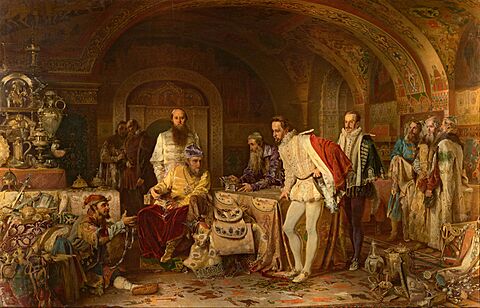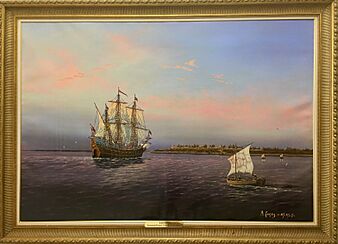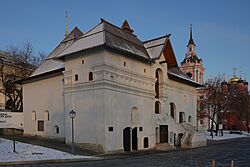Muscovy Company facts for kids
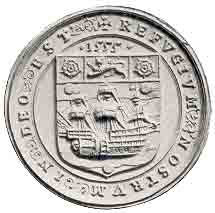
Seal of the Muscovy Company, showing the date 1555 above an escutcheon of arms: Barry wavy of six argent and azure, over all a ship of three masts in full sail towards sinister proper, sails, pennants, and ensigns of the first, each charged with a cross gules all between three bezants, a chief or, on a pale between two roses gules seeded or, barbed vert, a lion passant guardant of the fifth All encircled by motto: Refugium Nostrum in Deo Est ("Our Refuge is in God"). The ship is shown, unusually for heraldry, sailing towards the sinister, signifying "The East"
|
|
| Trading company; charity | |
| Industry | Trading company; now a charitable organization |
| Fate | Existed until 1917 as a trading company. Now operates mainly as a charity. |
| Predecessor | Company of Merchant Adventurers to New Lands |
| Founded | 6 February 1555 in England |
| Founders | Richard Chancellor, Sebastian Cabot and Sir Hugh Willoughby |
The Muscovy Company (also known as the Russia Company or the Muscovy Trading Company; Russian: Московская компания, romanized: Moskovskaya kompaniya) was an English trading company. It was officially given permission to operate in 1555. This company was one of the first big "joint-stock companies." This means many people bought shares in the company, sharing the risks and rewards. This new way of doing business helped England explore the world. The Muscovy Company had special permission to be the only English company trading with Russia until 1698. It continued as a trading company until the Russian Revolution in 1917. Since then, it has mostly worked as a charity in Russia.
Contents
Exploring New Lands: The Start of the Company
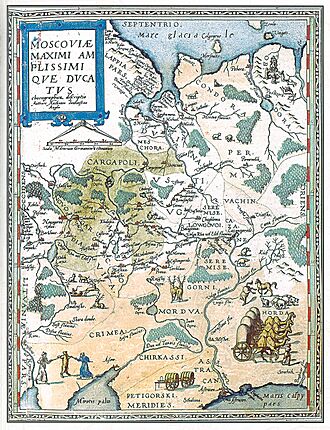
The Muscovy Company began as the "Company of Merchant Adventurers to New Lands." This group was started in 1551 by Richard Chancellor, Sebastian Cabot, and Sir Hugh Willoughby. Their main goal was to find a new sea route to China by sailing north, known as the Northeast Passage.
The First Journey: Hope and Danger
The first big trip for the Merchant Adventurers was led by Willoughby. He was a good military leader, but he had no experience sailing. Richard Chancellor was the navigator for the three ships: the Bona Esperanza (Willoughby's ship), the Edward Bonaventure (Chancellor's ship), and the Bona Confidentia.
The ships left London on May 10, 1553. Near the Lofoten islands, a big storm hit. Chancellor's ship got separated from the other two.
Willoughby's Tragic End
Willoughby's ships sailed across the Barents Sea and reached Novaya Zemlya. After exploring the coast, they turned south towards Scandinavia. But near the Varzina River, their ships got stuck in the ice.
Years later, Russian fishermen found the ships frozen solid. Inside, they found Willoughby and his crew. They had died, likely from carbon monoxide poisoning. They had enough food and warm clothes, so it's thought they burned sea coal for warmth in the enclosed ship, which produced deadly fumes.
Chancellor's Lucky Discovery
Chancellor was much luckier. His ship entered the White Sea. Local fishermen were amazed by his large Western ship. He reached a harbor near where Arkhangelsk is today.
The Russian Tsar, Ivan IV, heard about Chancellor's arrival. He immediately invited Chancellor to visit Moscow.
Chancellor traveled over 600 miles (970 km) through snow and ice to Moscow. He found Moscow to be a very large city, bigger than London. The Tsar's palace was very fancy, and he offered Chancellor luxurious dinners.
Ivan IV was happy to open new sea trade routes with England. At that time, Russia didn't have easy access to the Baltic Sea. Other countries like Lithuania, Poland, and Sweden controlled much of that area. Also, the Hanseatic League had a strong hold on trade between Russia and Western Europe.
Chancellor was also very hopeful. He saw a good market for English wool in Russia. In return, he could get furs and other Russian goods. When he returned to England in 1554, he brought letters from the Tsar. These letters invited English traders and promised them special trading rights.
The Muscovy Company is Born
In 1555, Queen Mary I of England officially re-established the Company of Merchant Adventurers as the Muscovy Company. That same year, Chancellor went back to Russia.
The Muscovy Company became a very important link between Russia and England. Russia, being quite isolated, valued this connection. When Chancellor met Ivan IV again, he got many special benefits for the company in Russia. These included free travel, control over English settlements, and protection from arrest.
However, Chancellor's luck ran out on his return trip in 1556. He was joined by the first Russian ambassador to England, Osip Grigoriyevich Nepeya. Off the Scottish coast, a sudden storm hit his ship, causing it to sink. Chancellor drowned. Ambassador Nepeya survived but was held by the Scots for a few months before he could travel to London.
Expanding Trade and Influence
Anthony Jenkinson took over from Chancellor as the main trader for the Muscovy Company. Jenkinson made two important journeys. One was an attempt to reach Cathay (China) by land from Moscow, but he only got as far as Bukhara. The other was to set up land trade routes through Russia to Persia between 1562 and 1579.
Even though Jenkinson proved the land route to Persia was possible, it was stopped in 1573 due to problems in the region. The route didn't reopen until 1741.
In 1567, during a difficult war for Russia (the Livonian War), Tsar Ivan IV asked Jenkinson to see if Queen Elizabeth I of England might marry him. This was a way for Ivan to have a safe place to go if he had to leave Russia. These talks didn't lead to a marriage.
In 1571, Ivan IV took away the company's right to free trade on the Volga River. He was upset because the English wanted Russia to stop trading with other European countries. Jenkinson returned to Moscow in 1572 and mostly succeeded in getting the company's special rights back. However, relations between England and Russia became cooler. This tension continued into the late 1500s.
Whaling and Arctic Exploration
Queen Elizabeth I gave the Muscovy Company a special right to hunt whales in 1577. The most profitable whaling areas for the company were around Spitsbergen in the early 1600s. In 1613, the company received a royal charter that gave them a monopoly on whaling in Spitsbergen. This was based on the mistaken idea that Hugh Willoughby had discovered the land in 1553.
The company also continued to search for the Northeast Passage. In 1556, Steven Borough sailed through the Kara Gates, a strait in the Arctic Ocean. In 1607 and 1608, the company sent Henry Hudson on two trips to find the Northeast Passage, but both failed.
Challenges and Changes
In 1646, Tsar Alexei I removed the Muscovy Company's special tax breaks. He did this because he believed the company supported the Parliamentarians in the English Civil War. After King Charles I of England was removed from power in 1648, Alexei I completely banned English merchants from Russia, except in Arkhangelsk.
When Charles II of England became king in 1660, relations between England and Russia improved a little. However, an attempt in 1664 to restore the Muscovy Company's old benefits failed. Meanwhile, Dutch merchants became the main traders in Russia. Still, the Muscovy Company kept its special right to English-Russian trade until 1698. At that point, it lost its privileges due to political reasons.
The Company Today
The Muscovy Company helped provide churches and Anglican priests in Russian cities like Arkhangelsk, Moscow, St. Petersburg, and Kronstadt. One example is St. Andrew's Anglican Church, Moscow.
The company continued to exist until the Russian Revolution of 1917. Since then, it has mainly operated as a charity. The company headquarters, called the Old English Yard, and St. Andrew's Church were built during the time of Ivan IV. They are not far from the Moscow Kremlin. In 1994, Queen Elizabeth II visited these historic sites.
See also
- List of trading companies


